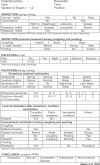Physiotherapy assessment for female urinary incontinence
- PMID: 32125491
- PMCID: PMC7210229
- DOI: 10.1007/s00192-020-04251-2
Physiotherapy assessment for female urinary incontinence
Abstract
Introduction and hypothesis: As noted in the 6th International Consultation on Incontinence (ICI) chapter "Initial Management of Urinary Incontinence in Women" recommendations call for including physiotherapy as a first-line therapy.
Methods: Building on this, checking available scientific evidence and using the International Classification of Functioning, Disabilities and Health, the following represents a holistic physiotherapist approach for initial evaluation of the health problem of urinary incontinence.
Results: This paper proposes a teaching module for every relevant health care professional dealing with the assessment of adult female urinary incontinence, focusing on optimal patient selection and appropriate treatment choice.
Conclusion: The assessment stage involves the explicit decision as to whether "physiotherapy" is the treatment indicated for the patient, based on the findings of the physiotherapy assessment and supplemented by any medical information that accompanied the referral and evaluation.
Keywords: (Pelvic) Physiotherapy; Assessment; Diagnostic; Female; Initial management; Psychometric measurement; Urinary incontinence.
Conflict of interest statement
All the other authors declare that they have no conflicts of interest to disclose.
Figures




References
-
- Abrams P, Andersson KE, Apostolidis A, Birder L, Bliss D, et al. Algorithm “Initial Management in Women”. Recommendations of the International Scientific Committee: evaluation and treatment of urinary incontinence, pelvic organ prolapse and faecal incontinence. In: Abrams P, Cardozo L, Wagg A, Wein A, editors. Incontinence. 6th International Consultation on Incontinence Tokyo, September 2016, ICS-ICUD 2017, p. 2569.
-
- Royal Dutch Society for Physiotherapy Guideline Stress (urinary) Incontinence. Supplement to the Nederlands Tijdschrift voor Fysiotherapie. 2011;121(3).
-
- Castro Diaz D, Robinson D, Bosch R, Costantini E, Cotterill N, et al. Initial assessment of urinary incontinence in adult male and female patients (5A). In: Abrams P, Cardozo L, Wagg A, Wein A, editors. Incontinence. 6th International Consultation on Incontinence, Tokyo, September 2016, ICS-ICUD 2017, p. 503.
-
- WHO . International Classification of Functioning, Disability and Health. Geneva, Switzerland: World Health Organisation; 2018.
-
- Tse V, King J, Dowling C, English S, Gray K, Miljard R, O’Connell H, Pillay S, Thavaseelan J. Guidelines: conjoint Urological Society of Australia and New Zealand (USANZ) and Urogynaecological Society of Australasia (UGSA) guidelines on the management of adult non-neurogenic overactive bladder. BJU Int. 2016;117:34–47. doi: 10.1111/bju.13246. - DOI - PubMed
MeSH terms
LinkOut - more resources
Full Text Sources
Medical
Research Materials
Miscellaneous

